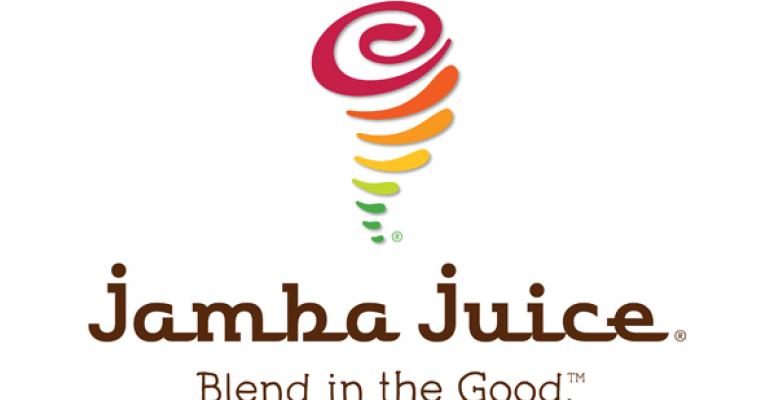The Jamba Juice smoothie brand is dramatically accelerating the systemwide rollout of its expanded fresh-juice platform, positioning itself as the first chain to take the “juicing” trend national.
Jamba Juice parent Jamba Inc. pledged on Thursday to bring its new fresh-juice format to 500 locations by June 2, six months earlier than previously stated, and plans to reach the entire 800-plus-unit domestic system by 2015.
“More consumers are jumping on the trend of juicing as better for you,” said Karen Luey, Jamba’s executive vice president and chief financial officer. “There’s not going to be another juice chain out there with the store base we have.”
RELATED
• Jamba Juice to accelerate growth of fresh-juice platform
• Jamba looks to fresh juice to boost sales
• More restaurant beverage trends
The rapid rollout is a response to the overwhelmingly positive consumer reaction to the pilot launch that began about 18 months ago. Units that have offered the juice program the longest are showing a 3-percent to 4-percent same-store sales lift. Systemwide same-store sales rose a more modest 0.3 percent during the chain’s April-ended first quarter, when only about 130 locations offered the fresh juices.
The juice platform rollout includes a store remodel with a design that shows off the fresh fruits and vegetables used for the drinks. Luey said the design aims to hit certain “freshness cues,” and will take customers on a “health-and-wellness journey.”
Rather than balking at the remodel investment, Jamba’s franchisees are standing in line to do the refresh, she added. About half of the 500 units scheduled to offer the fresh-juice platform by June are franchised locations, indicating strong franchisee buy in.

With the rollout, Jamba is also developing its network of suppliers across the country, pledging the produce used in each location will be local and will have gone “from ground to cup” in no more than three days.
As a result, units will receive shipments more frequently during the week, and the company has developed systems to ensure ingredients are available in all markets, Luey said.
The company has also developed a training program called a “Master of Blending Arts,” or MBA, to train workers on the juice blends, speed of service and the nutritional aspects of juicing.
The brand evolution is a return of sorts to Jamba Juice’s roots. The chain was founded in 1990 as the Juice Club, offering made-to-order juice drinks. Over the years, however, it became known more for its smoothies, often made with frozen fruit, frozen yogurt and sweeteners, which have fallen out of favor in some nutrition circles.
Over the past five years, however, celebrities have touted the health benefits of fresh-juice cleanses, or “juicing” for meal replacements and as a nutritional supplement. Trendy juice bars have popped up across Los Angeles and New York featuring fruit-and-vegetable blends with ingredients like kale, beets, cucumbers, various fruits, Greek yogurt and chia seeds.
In a recent report, research firm IBIS World said the estimated $2.2 billion juice craze has hit the mainstream, with juices selling at higher price points. However, competition is growing from more shelf-stable cold-pressed juice producers and retail brands.
Starbucks acquired the Evolution Fresh brand in 2011 and launched its own juice-based concept by the same name, for example. Southern California-based chains like Nekter Juice Bar Inc., with nearly 30 locations, are rapidly expanding with fresh juice offerings.
Unlike some juice bars, however, Jamba Juice’s menu includes some blended offerings that incorporate the whole fruit, including the fiber-filled pulp that offers more health benefit than squeezed juice alone.
Luey said Jamba Juice has been evolving its health-and-wellness emphasis since James White was named chief executive about five years ago, and the juice platform is one component.
Though the fresh-juice platform has taken some business from the traditional smoothie line, juice customers are more likely to visit more frequently, looking for their daily fruit and vegetable servings, Luey said.
The rollout will be supported by a “Blend in the Good” marketing campaign, which launched May 1, and includes a refreshed company website, social media and video, as well as radio and events that include dietitians, athletes and fitness celebrities who will share health and wellness advice.
At the end of the first quarter, the Jamba Juice chain included 854 units globally, including 263 company-owned and 544 franchised units in the U.S.
Contact Lisa Jennings at [email protected].
Follow her on Twitter: @livetodineout





